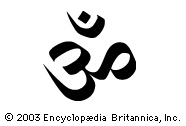Om
Hindu concept
 in Hinduism and other religions chiefly of India, a sacred syllable that is considered to be the greatest of all the mantras, or sacred formulas. The syllable Om is composed of the three sounds a-u-m (in Sanskrit, the vowels a and u coalesce to become o), which represent several important triads: the three worlds of earth, atmosphere, and heaven; the three major Hindu gods, Brahmā, Vishnu, and Śiva; and the three sacred Vedic scriptures, Ṛg, Yajur, and Sāma. Thus Om mystically embodies the essence of the entire universe. It is uttered at the beginning and end of Hindu prayers, chants, and meditation and is freely used in Buddhist and Jaina ritual also. From the 6th century, the written symbol-->
in Hinduism and other religions chiefly of India, a sacred syllable that is considered to be the greatest of all the mantras, or sacred formulas. The syllable Om is composed of the three sounds a-u-m (in Sanskrit, the vowels a and u coalesce to become o), which represent several important triads: the three worlds of earth, atmosphere, and heaven; the three major Hindu gods, Brahmā, Vishnu, and Śiva; and the three sacred Vedic scriptures, Ṛg, Yajur, and Sāma. Thus Om mystically embodies the essence of the entire universe. It is uttered at the beginning and end of Hindu prayers, chants, and meditation and is freely used in Buddhist and Jaina ritual also. From the 6th century, the written symbol--> designating the sound is used to mark the beginning of a text in a manuscript or an inscription.
designating the sound is used to mark the beginning of a text in a manuscript or an inscription.The syllable is discussed in a number of the Upanishads, which are the texts of philosophical speculation, and it forms the entire subject matter of one, the Māndūkya. It is used in the practice of Yoga and is related to techniques of auditory meditation. In the Purāṇas the syllable is put to sectarian use; thus the Saiva mark the lingam, or sign of Śiva, with the symbol for Om, whereas the Vaishnava identify the three sounds as referring to a trinity composed of Vishnu, his wife Śrī, and the worshiper.